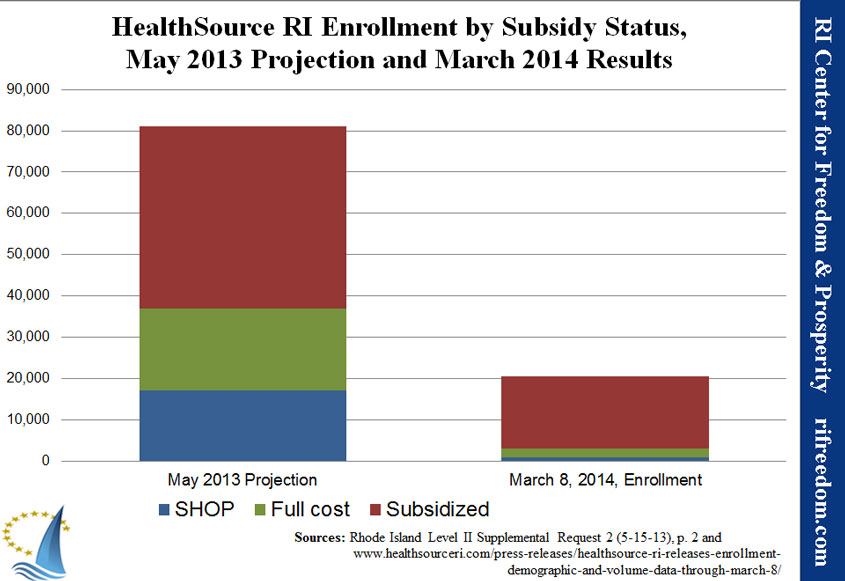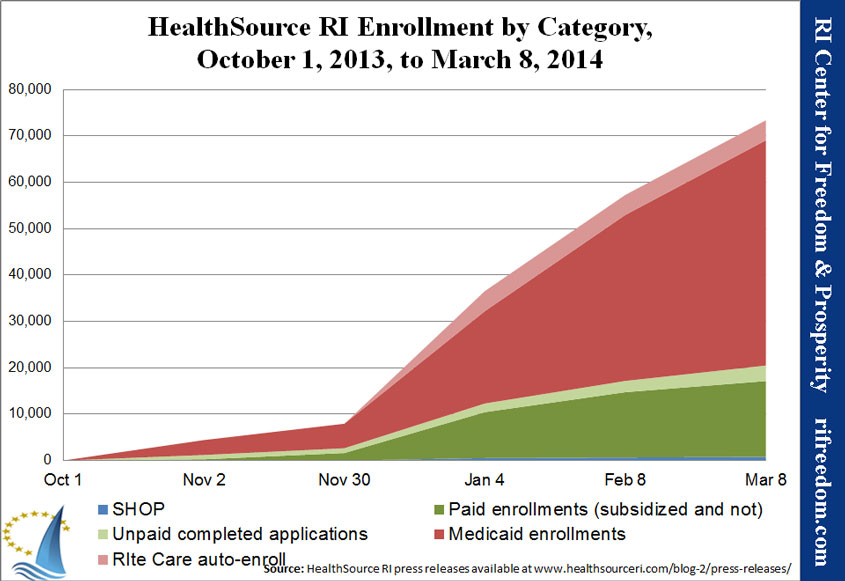RI Health Benefits Exchange Costs Exceeding Even Center’s Projections
Implementation of the Affordable Care Act (ACA) in Rhode Island, with both the health benefits exchange (called HealthSource RI) and the expansion of Medicaid to cover able-bodied low-income adults, has been a lesson in government operation. The policies were put into place — and over $100 million in federal tax dollars were spent — without significant public discussion and with no plan to cover the costs, and we’re now learning that projections of costs were wrong in several critical aspects.
The total cost to the state in fiscal year 2015 (FY15) could be as much as $100 million.
Enrollment
When the General Assembly declined to create a health benefits exchange through legislation, now-Democrat Governor Lincoln Chafee did so by executive order. In the text of that order, issued September 2011, the governor explicitly decreed that “No state general revenues shall be used for purposes of the [exchange], and no liability incurred by the [exchange] or any of its employees may be satisfied using state general revenues.”
The order mentions the possibility that funds would come from “insurers or other entities,” so it’s probable that the governor’s office expected the exchange to be self-sustaining, as a government-run start-up company.
A grant application to the federal government in March 2011, by Deb Faulkner, the state’s Exchange Project Coordinator, projects that 2014 would find 127,000 Rhode Islanders enrolled in private health plans through the exchange, with 32,000 of them paying the full cost of their coverage, with no state or federal subsidies. Another 77,000 people were expected to be enrolled through the business-focused component of the exchange, called the Small Business Health Options Program (SHOP).
Under those circumstances, the governor may have expected small transaction fees to be sufficient to cover the cost of the exchange.
In May 2013, another grant application, this one from HealthSource RI director Christine Ferguson, cites a projection developed in cooperation with MIT economics professor Jonathan Gruber. Five months before the launch of the exchange, the state was still expecting 64,000 private enrollees, with 20,000 of them paying the full cost, plus 17,000 in SHOP.
Local news reports cite an “unofficial” memo from the U.S. Centers for Medicaid and Medicare to say that actual enrollment is “far above federal targets.” However, the results are well below the more-official expectations in the applications. As of March 8 of this year, the exchange had enrolled 19,690 people (17% of whom had not yet paid and arguably should not be included until they do), with only 2,284 paying the full cost, plus 795 in SHOP.
The following chart compares the May 2013 projections with HealthSource RI’s results thus far.
In total, the projection was almost four times higher than the results that the exchange had achieved by March 8. Looking at just the full-cost individual plans, the projections were overly optimistic almost by a factor of nine times. This leaves the exchange’s annual budget of nearly $25 million up in the air.
Medicaid
As if the failure of the exchange’s cost structure weren’t bad news enough, the results from the Medicaid portion of the ACA make matters worse.
According to a report by Philip Marcelo, in today’s Providence Journal, the state had expected 51,000 people to enroll in Medicaid within the first 18 months after the introduction of the Medicaid expansion and the health benefits exchange. In actuality, six months into that period, Medicaid enrollment is already up by 48,602.
The following chart shows the trends in each category of enrollee, as HealthSource RI has reported them (roughly month to month). The dark red area represents Medicaid recipients.
After an initial surge leading up to the deadline to receive coverage starting January 1st, enrollment in paid programs has tapered off considerably, while growth in the Medicaid population has remained strong.
The number of people enrolling in paid insurance plans may experience another boost during this month, as the open-enrollment period comes to a close at the end of the month. The flip side of that possibility, however, is that there is no enrollment deadline for Medicaid, so costs may continue to balloon beyond what the RI House Fiscal staff projects.
Multiple calls and emails to various parties for clarification of House Fiscal’s findings have received no reply, as of this writing, but the circumstances may be more dire than is being reported.
According to Marcelo, the House Fiscal staff expects the cost of the Medicaid expansion — which the state government appears to have accepted as an administrative decision, with no public debate at all — to affect the state’s general fund budget for the first time in fiscal year FY17, with an expense of $14.2 million (on a total cost of the expansion of $570 million that year). That amount grows each year, as the state’s contribution phases up to 10% of the $719 million total, or $71.9 million, in 2021.
That isn’t the whole story, however.
Secretary of Health and Human Services Steven Costantino credits the state’s taxpayer-funded public awareness campaign with the high number of Medicaid enrollees. As individuals visit the HealthSource RI Web site, the system tells them whether or not they are eligible for Medicaid. Many of them would have been eligible without the expansion.
According to a HealthSource spokesperson, 33.3% of all Medicaid enrollments through the exchange as of February 8 (or 11,916) would already have been eligible for the public welfare program without the expansion. The federal government only picks up 50-55% of the cost for these Medicaid recipients.
It isn’t clear how (or whether) these enrollees factored into the House Fiscal staff’s analysis, but their cost in FY15 — the budget under consideration right now — could be around $74 million.
In a press conference announcing the Medicaid expansion on the day the Supreme Court ruled the ACA constitutional, in 2012, Costantino estimated that the expansion would only apply to 6,000 to 7,000 people. Even less optimistic estimates made by the RI Center for Freedom & Prosperity at the time put the total cost of the ACA much lower than now appears probable.
As Costantino acknowledges, although insisting it’s an outcome of which to be “proud,” as the state engages in an aggressive campaign to bring in new paying customer’s, it’s not attracting them, but rather new recipients of government handouts.
The people of Rhode Island were never given a chance to fully debate, much less vote on, these changes to government policy. Even now the layers of government spin and incomplete reportage leave them — even their elected representatives — with little understanding of how significant the costs are going to be, especially in comparison with the program they were sold.
Featured image: Stephen Costantino, Lt. Gov. Elizabeth Roberts, and Christine Ferguson at the June 28, 2012, press conference concerning the exchange and the Medicaid expansion.



Leave a Reply
Want to join the discussion?Feel free to contribute!